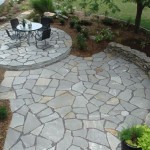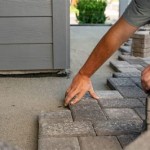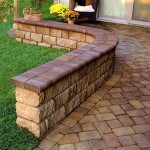How to Build a Small Patio with Pavers and Stones on a Concrete Slab
Constructing a small patio with pavers and stones atop a concrete slab can significantly enhance outdoor living spaces. This project, while manageable for the determined homeowner, requires careful planning, preparation, and execution. The presence of a concrete slab provides a stable foundation, simplifying the process compared to building directly on soil. This article outlines the essential steps involved in creating a durable and aesthetically pleasing patio using pavers and stones over an existing concrete slab.
Preparation and Planning
Prior to commencing any physical work, meticulous planning is essential. This phase involves accurately measuring the concrete slab to determine the patio's size and shape. A scaled drawing of the intended patio layout should be created, specifying the dimensions, paver and stone patterns, and any edging details. This drawing serves as a blueprint throughout the construction process, preventing errors and ensuring a cohesive final product.
Material selection is another critical aspect of planning. Choose pavers and stones that complement the existing landscape and architectural style of the house. Consider factors such as color, texture, size, and durability. Pavers are available in various materials, including concrete, brick, and natural stone. Each material offers distinct aesthetic qualities and varying levels of resistance to weathering and wear. Ensure that the selected materials are suitable for outdoor use and can withstand the local climate conditions.
Calculate the quantity of pavers and stones required based on the patio's dimensions and the chosen layout pattern. It is advisable to order approximately 5-10% extra material to account for cuts, waste, and potential breakage. Don't overlook the importance of edging. Edging restraints such as plastic, metal, or concrete edging are crucial for preventing pavers from shifting or separating over time. The type of edging selected should complement the overall aesthetic of the patio and provide adequate support.
Furthermore, consider drainage requirements. While the existing concrete slab may already have a slight slope to facilitate water runoff, assess the area for potential water accumulation. If necessary, adjustments to the paver installation can be made to improve drainage. This might involve slightly sloping the paver surface or incorporating drainage channels.
Finally, gather all necessary tools and equipment. Essential tools include a measuring tape, level, rubber mallet, trowel, broom, safety glasses, work gloves, and a wet saw (for cutting pavers and stones to size). A wheelbarrow or utility cart will be useful for transporting materials. Securing the right tools beforehand will streamline the construction process and minimize delays.
Surface Preparation and Mortar Bed Installation
The concrete slab must be thoroughly cleaned before installing the mortar bed. Remove any dirt, debris, loose particles, or existing coatings using a broom, pressure washer, or scraper. Ensure the surface is free from oil, grease, or any other contaminants that could hinder adhesion of the mortar bed. A clean and stable surface is paramount for a long-lasting patio.
Inspect the concrete slab for any cracks or imperfections. Small cracks can be filled with a concrete patching compound. Larger cracks may require more extensive repair or professional assessment to ensure the structural integrity of the slab. Addressing any underlying issues with the concrete slab is crucial for preventing future problems with the paver installation.
Prepare a mortar bed mix according to the manufacturer's instructions. The mortar bed acts as a bonding layer between the concrete slab and the pavers, providing a level surface and securing the pavers in place. A typical mortar mix consists of cement, sand, and water. Proper mixing is essential to achieve the correct consistency. The mortar should be moist but not overly wet, allowing it to be easily troweled and hold its shape.
Apply the mortar bed to the concrete slab using a trowel. Spread a layer of mortar approximately 1-2 inches thick, ensuring a consistent depth across the entire area intended for paver installation. Use a notched trowel to create grooves in the mortar bed, which will enhance adhesion between the mortar and the pavers. Work in small sections, applying the mortar bed only to the area that can be covered with pavers within a reasonable timeframe. This prevents the mortar from drying out before the pavers are set.
Use a level to check the mortar bed for proper slope and evenness. Make any necessary adjustments to ensure a smooth and level surface. A slight slope away from the house is recommended to facilitate water runoff. Minor imperfections in the mortar bed can be corrected as the pavers are being set.
Paver and Stone Installation and Finishing Touches
Begin laying the pavers and stones according to the planned layout pattern. Gently press each paver into the mortar bed, ensuring it is firmly seated and level with adjacent pavers. Use a rubber mallet to tap the pavers into place, further embedding them into the mortar. Maintain consistent spacing between the pavers, typically around 1/8 to 1/4 inch, to allow for joint filling.
Periodically check the level of the paver surface using a level. Make any necessary adjustments by adding or removing mortar beneath the pavers. It is crucial to maintain a consistent level across the entire patio surface to prevent tripping hazards and ensure proper drainage. Minor variations in paver thickness can be compensated for by adjusting the mortar bed accordingly.
When reaching the edges of the patio, it may be necessary to cut pavers and stones to fit the desired shape. Use a wet saw equipped with a diamond blade to make clean and precise cuts. Wear safety glasses and gloves when operating the wet saw. Cut the pavers slightly larger than necessary and fine-tune the fit by chipping away small pieces with a hammer and chisel if needed.
Install the edging restraints around the perimeter of the patio to prevent paver movement. The edging should be flush with the paver surface or slightly below, depending on the type of edging used. Secure the edging in place using appropriate fasteners, such as spikes or stakes, driven into the ground or concrete slab. Ensure the edging is firmly anchored to provide adequate support.
After the mortar bed has fully cured (typically 24-48 hours), sweep polymeric sand into the joints between the pavers. Polymeric sand is a special type of sand that contains polymers that bind the sand particles together, creating a durable and weed-resistant joint filler. Follow the manufacturer's instructions for application. Wet the polymeric sand with a fine mist of water to activate the polymers. Avoid overwatering, as this can wash away the sand. Allow the polymeric sand to dry completely before using the patio.
Finally, clean the paver surface with a broom or pressure washer to remove any excess sand or debris. Inspect the patio for any imperfections or issues that may require attention. Minor adjustments can be made to the pavers, edging, or joint filling as needed. Consider applying a paver sealant to protect the pavers from staining and weathering. The sealant will also enhance the color and appearance of the pavers.
Key Considerations for Longevity
Proper drainage is paramount. Even with a pre-existing concrete slab, it is crucial to ensure that the patio surface has adequate slope to allow water to drain away from the house and prevent water from pooling on the surface. Pooling water can lead to efflorescence, algae growth, and damage to the pavers over time. Consider installing subsurface drainage if necessary to improve water runoff.
Regular maintenance is essential. Sweep the patio regularly to remove leaves, dirt, and debris. Wash the patio with a mild detergent and water as needed to remove stains and grime. Inspect the pavers and joints periodically for any signs of damage or wear. Repair any cracks or loose pavers promptly to prevent further damage. Reapply paver sealant every few years to maintain the protective coating.
Choosing the right materials is critical. Select pavers and stones that are specifically designed for outdoor use and can withstand the local climate conditions. Opt for high-quality materials that are resistant to weathering, staining, and fading. Consider the long-term durability and maintenance requirements of different paver materials before making a selection. Proper material selection will ensure the longevity and aesthetic appeal of the patio for years to come.

How To Diy A Concrete Paver Pea Gravel Patio The Collected House

See How 3 Patios Ingeniously Mix Pavers And Pebbles

How To Install Pavers Over A Concrete Patio Family Handyman

Diy Pea Gravel Patio With Pavers Love Renovations

How To Build A Paver Patio Rogue Engineer

How To Build A Patio An Easy Do It Yourself Project

How To Diy A Concrete Paver Pea Gravel Patio The Collected House

Diy Pea Gravel Patio With Pavers Love Renovations

How To Build A Backyard Paver Patio All By Yourself

Paver Patios Install A Diy Patio With Brick Or Stone Decks Com
Related Posts








